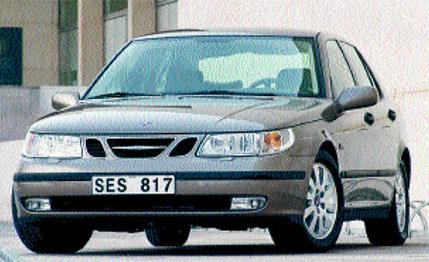 First Drive Review
First Drive Review
Some numbers are hard to swallow. For example, a guy on the radio says there are more than 4000 toxic materials in a cigarette. Say what? And how about this one: The new Saab 9-5 sedan shown here has undergone 1265 changes.
Doesn't look it, huh? Well, it wasn't likely General Motors would pay something around $1.5 billion to buy Saab (the final payment came in 2000) and then turn its curious-looking cars into a line of Buick Century look-alikes, now was it?
Of the 1265 changes, a handful are notable: The most-powerful engine, a 16-valve DOHC turbocharged four-cylinder of 2.3 liters, now cranks out another 20 horsepower, to 250; it will reside only in the zoomy Aero model. An excellent new five-speed automatic replaces the four-speed, and an electronic stability program joins a traction-control system in preventing owners from having to pick weeds from the grille. The suspension has undergone a retuning, and optional xenon lighting provides both high- and low-beam illumination (with halogen backup on the high beams) to double the light of the previous halogen-only system.
A major change involves the way the 9-5 sedans and wagons will be marketed. Saab has dumped the traditional S and SE designations and chosen a new scheme it describes as three "architectural forms," apparently a new way of saying "models" in the same way "problems" today are called "issues." The "forms" are Linear (read, standard), Arc (luxury/touring), and Aero (performance).
When the new cars arrive this month, the entry-level 9-5 Linear will appear with that 2.3-liter turbocharged and intercooled motor tuned to a less-raucous 185 horsepower and 207 pound-feet of torque. It gets the five-speed automatic as an option or the standard five-speed manual and new 10-spoke alloy wheels bearing 215/55-16 all-season Michelins. The Arc gets the carried-over 24-valve, 200-hp turbo V-6 with 229 pound-feet of torque, which comes only with the five-speed automatic, and the same rubber and wheels as on the Linear. The top-of-the-line Aero sports the 250-hp turbo four, a manual transmission as standard, and 225/45-17 Michelins. All Saabs come with a lot of standard bells and whistles, including leather, sunroof, air, power seats (heated up front) and windows, and sound systems. The Linear and Arc interiors have walnut trim around the wonderfully designed aircraft-style module, and the Aero's trim has a high-tech metal look. Upgrade packages involve a Harman/Kardon sound system, the stability-control system, rain-sensing wipers, the xenon lights in the Arc and Aero lines, and other niceties.
Body changes are hardly perceptible. The basic shape dates back to the 9000 model of 1985, which was the curious offspring of an unlikely liaison with Italian company Fiat. The new 9-5 is about an inch longer (190.0 inches overall), the bumpers are rounder, and the grille openings are framed by chrome. But no one will mistake it for anything but a Saab.
The 9-5 owes much of its appeal to the elegant and richly hued interiors, which include perforated leather to go with the little motors that ventilate the seats in the Arc model. Perhaps this car's genuine strong point is the remarkably roomy and comfy feel it provides for four adults.
On a 200-mile test drive, we sensed that the new Aero sedan with the five-speed automatic might be quicker than the manual-shifting model, er, form. When shifting for speed, there are momentary flat spots between the gears that, were you racing your obnoxious brother in his 3-series, add up to time lost. But the shift points of the new five-speed automatic seem perfectly placed along the power path, and step-off feels much stronger. Previous Aeros with automatics have had to live with 15 fewer pound-feet of torque than the 258 total found in the manually shifted model, but the automatic can now accept the full torque quota without misbehaving, and when you add in the 9-5's 20-second overboost feature, the automatic feels quicker.
Saab sold nearly 40,000 cars in the U.S. in 2000, and about 133,000 in all the world. It expects to equal those sales this year, despite the planet's economic nose dive. As far as sales numbers go, those seem like inconsequential ones to a monster automaker such as GM - it sold nearly five million vehicles in the U.S. alone last year - but 9-5s come with big-league prices, and the new line ranges from $34,620 to $42,890. Well, never fear - Saab has cooked up some fairly impressive numbers of its own. In four or five years, this newest GM Euro division expects sales to leap to 250,000. This can be accomplished, the marketing mavens say, because it's been determined that there are, or will be, at least 10 million likely customers for its cars.
As we said, some numbers are harder to swallow than others.